The best ways to prepare beet leaves for the winter and recipes for them
Beet tops are the green leaves and petioles of the root crop. Their shape and color depend on the plant variety. Beetroot tops have been used as food since the times of the ancient Greeks. They were valued for their taste and beneficial properties.
In this article we will talk about the chemical composition of tops and its effect on the human body. You will learn how to prepare beet leaves for the winter and what dishes can be made from them.
Composition and benefits of beet tops
Beet leaves help maintain health and replenish vitamin and mineral deficiencies - and this is all thanks to their unique chemical composition.
Table of vitamin and mineral composition:
| Name | Content | Norm |
| Vitamin A | 383 mcg | 900 mcg |
| Beta carotene | 4.59 mg | 5 mg |
| Vitamin B1 | 0.117 mg | 1.5 g |
| Vitamin B2 | 0.289 mg | 1.8 mg |
| Vitamin B4 | 0.5 mg | 500 mg |
| Vitamin B5 | 0.329 mg | 5 mg |
| Vitamin B6 | 0.132 mg | 2 mg |
| Vitamin B9 | 14 mcg | 400 mcg |
| Vitamin C | 24.9 mg | 90 mg |
| Vitamin E | 1.81 mg | 15 mg |
| Vitamin K | 484 mcg | 120 mcg |
| Vitamin PP | 0.499 mg | 20 mg |
| Potassium | 909 mg | 2500 mg |
| Calcium | 114 mg | 1000 mg |
| Magnesium | 68 mg | 400 mg |
| Sodium | 241 mg | 1300 mg |
| Phosphorus | 41 mg | 800 mg |
| Iron | 1.9 mg | 18 mg |
| Manganese | 0.514 mg | 2 mg |
| Copper | 251 mcg | 1000 mcg |
| Selenium | 0.9 mcg | 55 mcg |
| Zinc | 0.5 mg | 12 mg |
Nutritional value of beet tops (per 100 g):
- calorie content – 27 kcal;
- proteins – 2.6 g;
- fats – 0.2 g;
- carbohydrates – 2.6 g;
- fiber – 2.9 g;
- water – 89.13 g.
The rich chemical composition of beet leaves has a beneficial effect on the body when consumed regularly:
- normalizes metabolism and blood sugar levels, which is especially important for diabetics;
- cleanses the blood and ducts of blood vessels from cholesterol plaques;
- increases hemoglobin levels;
- reduces the risk of stroke, heart attack, pathologies of veins, arteries and heart muscle;
- promotes weight loss;
- improves concentration;
- minimizes the risk of developing fetal neural tube pathologies;
- destroys and removes free radicals;
- regulates intestinal function due to fiber;
- replenishes the supply of vitamins, micro- and macroelements;
- stops the deterioration of vision.
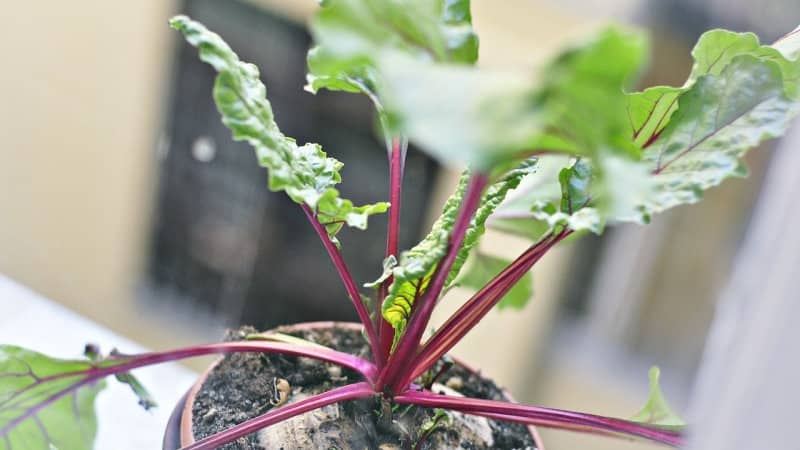
Harm and contraindications
Beet tops contains oxalic acid in large quantities. When reacting with minerals, compounds are formed that accumulate in tissues and are difficult to remove from the body. This provokes the development of urolithiasis.
Doctors recommend approaching the use of beet leaves from a rational point of view, taking into account the stage of the disease. Drinking plenty of fluids helps reduce the harmful effects of oxalic acid.
Direct contraindications include:
- bleeding disorders and taking anticoagulants (vitamin K greatly thins the blood);
- pathologies of the kidneys and gallbladder;
- chronic diarrhea;
- pancreatitis;
- liver cirrhosis, hepatitis;
- low blood pressure.
Storage options
The following methods help preserve beet tops for the winter:
- canning;
- pickling;
- drying;
- freezing;
- fermentation.
Heat treatment slightly reduces the amount of vitamins and minerals. Freshly frozen, dried and pickled tops are considered the most useful.
Leaves pickled in vinegar keep in the pantry for a long time. They are used as a savory addition to meat, fish, cereals and vegetables.
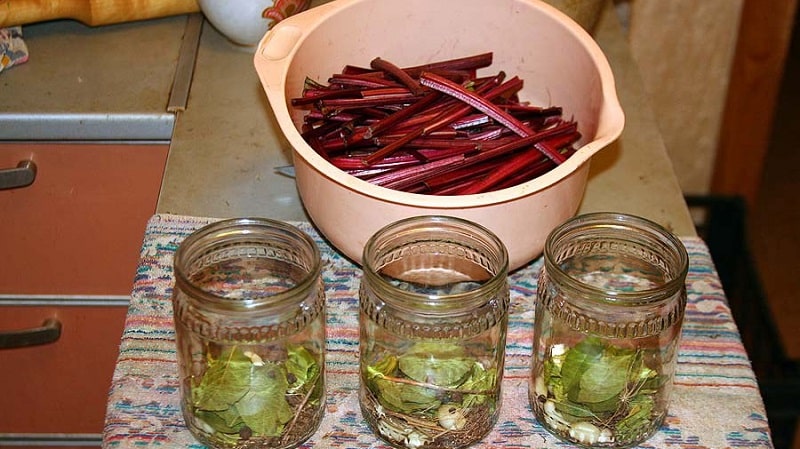
Canning
The fastest and least labor-intensive way to prepare leaves in jars is five-minute preservation:
- Wash the beet leaves, finely chop them, place them in a saucepan, add salt and cover with cold water.
- Bring to a boil and cook for 5 minutes.
- Place in clean jars and seal.
- Store in the cellar.
Pickling
You can pickle both leaves and petioles of beets, but their processing will be different.
The petioles are harvested using the triple pouring method: The hot marinade is poured, drained, boiled and re-filled three times.
Leaves are prepared by sterilization method: The hot marinade is poured into jars and boiled for 5 minutes. Cover the blanks with lids, turn them over and wrap them in a blanket.
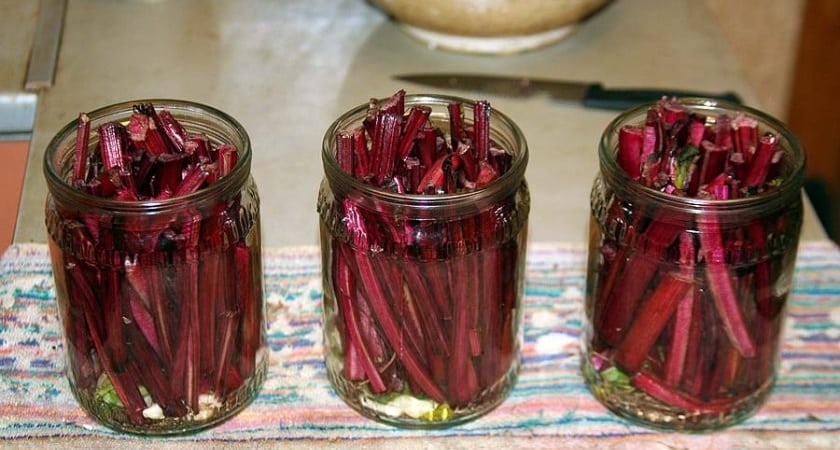
Drying
Beet leaves contain practically no essential oils, so they can be dried immediately after cutting. For this purpose, use an oven, dehydrator or electric dryer. Drying temperature – no more than 60°C.
Dried tops are used in folk medicine to treat constipation, headaches and mastitis.
Reference. It is not recommended to dry the tops under the sun: the leaves lose all their beneficial substances.
Freezing
One of the best ways to preserve greens for the winter without losing useful components:
- Wash the leaves, dry and finely chop.
- Place into freezer bags in small portions.
- Place in the freezer.
Advice. Do not re-freeze as the product loses its beneficial properties.
Pickling
Beet tops, fermented without vinegar, have a wonderful taste and a lot of useful properties. Moreover, its chemical composition multiplies several times.It can be stored for a long time and not spoil. Fermented foods speed up metabolism and the digestion process by normalizing intestinal microflora.
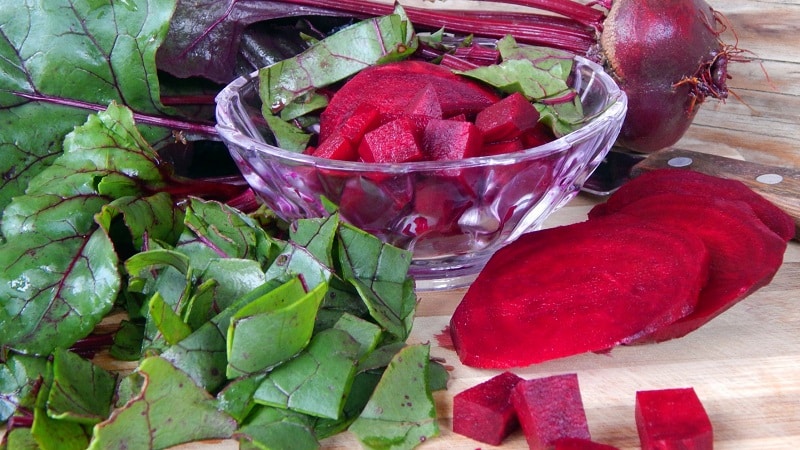
How to properly store workpieces
Rules for storing beet tops depend on the harvesting method:
- Pickled and canned ones are kept in the refrigerator or cellar.
- The dried ones are placed in paper bags or linen bags and hidden in a dark place.
- Frozen leaves are stored at temperatures from -5°C to -20°C. The lower the temperature, the longer the shelf life, on average 10 months.
- Tops pickled with vinegar are stored in the pantry or taken to the basement for safety.
Recipes for the winter
The most popular methods for preparing beet leaves include fermentation and pickling. Let's talk about the features of each of them in more detail. Even novice cooks will not have any difficulties in cooking.
Pickled tops
Ingredients:
- beet tops – 1 kg;
- garlic – 30 g;
- dill umbrellas – 2 pcs.;
- black currant or cherry leaves - 3 pcs.;
- salt – 2 teaspoons.
Preparation:
- Wash the beet leaves, dry and chop coarsely.
- Place in layers in a clean container for fermentation, topped with chopped garlic, currant leaves and dill. Sprinkle each layer with salt.
- Place pressure on top.
- Keep at room temperature for three days.
- Take the workpiece to a cool place for storage.
Pickled tops
Ingredients:
- beet tops – 1 kg;
- apple cider vinegar – 120 ml;
- salt – 35 g;
- clean water – 1.5 l;
- black or allspice, Bay leaf, dill umbrellas - taste.
Preparation:
- Wash the leaves, chop coarsely and place in a clean container.
- Prepare a marinade from water, salt, spices, dill and vinegar.
- Strain and pour over the beet leaves.
- Place the container in a water bath and pasteurize for 15 minutes.
- Close with airtight lids and store in the cellar.
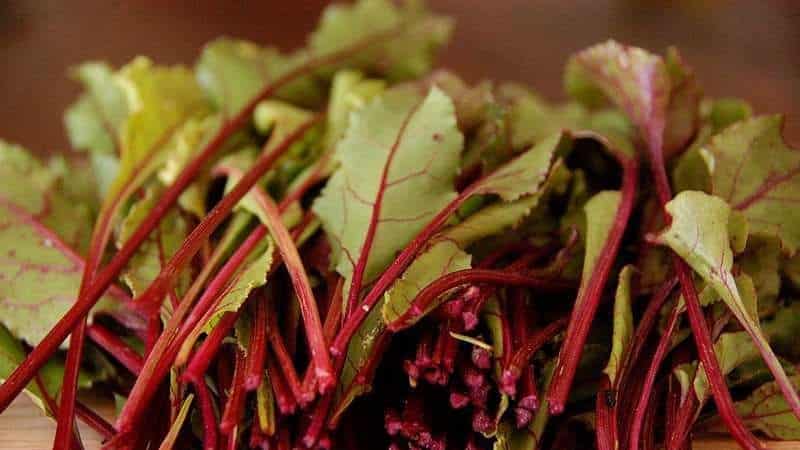
Recipes for dishes with beet leaves
Beetroot tops are used to prepare many dishes familiar to us: soups, salads, cabbage rolls, dumplings, Ossetian pies. We have selected several popular and simple recipes.
Stuffed cabbage rolls
Ingredients:
- medium-sized beet leaves;
- minced meat – 600 g;
- long grain rice – 400 g;
- carrots – 2 pcs. (medium size);
- onion – 1 pc. (big);
- tomato paste – 3 tbsp. spoons;
- sour cream – 150 ml;
- salt, spices - to taste;
- sunflower oil for frying onions and carrots.
Preparation:
- Grate the carrots on a coarse grater, cut the onion into small cubes and lightly fry in oil.
- Boil the rice until half cooked, cool and mix with the minced meat.
- Add sautéed vegetables, salt and pepper to taste.
- Rinse the beet leaves under running water, remove the petioles and cut off the thick vein.
- Wrap the minced meat in each leaf, forming cabbage rolls.
- Place them tightly together in the pan.
- Make the dressing: mix sour cream with tomato paste, add salt and pour in hot water. Stir and pour over the cabbage rolls.
- Place a flat plate on top with a diameter smaller than the pan.
- Cover with a lid and simmer over low heat for about an hour.
Green salad
This salad is a real vitamin bomb.
Ingredients:
- tops - 1 bunch;
- wild garlic – 1 bunch;
- parsley and dill – 1 bundle;
- cucumber – 1 pc.;
- paprika - 1 PC.;
- olive oil – 3 tbsp. spoons;
- apple cider vinegar – 1 tbsp. spoon;
- salt, black pepper - to taste.
Preparation:
- Wash the greens, dry and finely chop.
- Chop the cucumber and pepper as desired.
- Mix the salad ingredients in a bowl, add salt, olive oil and vinegar.
- Let it brew and serve.
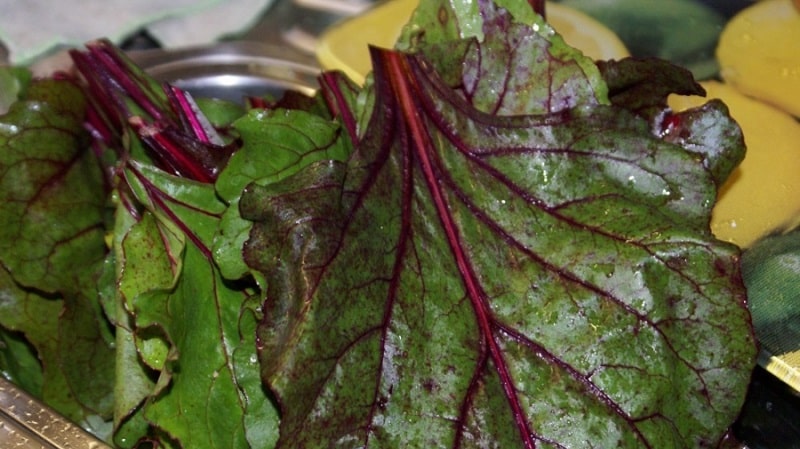
Soup
Ingredients:
- meat on the bones for broth;
- water – 3 l;
- beet leaves - 2 bunches;
- potatoes – 3 pcs.;
- carrots – 1 pc.;
- onion – 1 pc.;
- vegetable oil – 2 tbsp. spoons;
- herbs, salt, spices - to taste.
Preparation:
- Rinse the meat and cover with water. Cook over low heat and skim off foam periodically. For pork, two hours of cooking is enough, for beef - three.
- Cut the potatoes into cubes or strips and soak in cold water. Grate the carrots and finely chop the onion. Sauté in vegetable oil until soft.
- Wash the beet leaves and finely chop them along with the petioles.
- Remove the meat and add the potatoes to the broth. Cook for 5-7 minutes, then add beet tops and sautéed vegetables.
- At the end of cooking, add salt, pepper and herbs. Serve with sour cream.
Dressing for borscht
Ingredients:
- beets – 1 kg;
- tops – 1 kg;
- onion – 1 kg;
- carrots – 1 kg;
- tomatoes – 1 kg;
- sugar and salt - to taste;
- vinegar 9% – 50 ml;
- refined oil – 3 tbsp. spoons.
Preparation:
- Grate the beets and carrots on a coarse grater or cut into strips.
- Chop the onions and tomatoes into medium cubes.
- Finely chop the washed tops.
- Pour oil into a thick-bottomed pan and add carrots. After 2-3 minutes, add the onion and sauté until soft.
- Add the beets, stir and pour in 200 ml of boiling water. Cover the pan with a lid and simmer the vegetables for 15 minutes.
- Add topstalks, tomatoes, 1 tbsp. spoon of sugar and salt. Stir and simmer for another 15 minutes.
- Taste the dressing and add vinegar, sugar and salt. Add beet leaves, stir and bring to a boil.
- Place the dressing in sterile containers and close the lids.
- Store in a cool place.
Reference. You can not use the root vegetable, but cook it only with beet leaves. The ingredients for refueling will be the same.
Borscht based on dressing
Ingredients:
- boiled water – 3 l;
- borscht dressing with beet tops – 500 ml;
- potatoes – 4 pcs.;
- salt, pepper, herbs - to taste;
- sour cream for serving;
- boiled eggs.
Dressing with beet leaves significantly reduces cooking time borscht. All that remains is to add chopped potatoes, salt and pepper to taste. Place greens, a tablespoon of sour cream and a boiled egg on each plate, if desired.
The total cooking time takes no more than 15-20 minutes, since the vegetables in the dressing are completely cooked.
If you are preparing borscht based on a dressing without beets, grate the root vegetable separately and add to the pan 10 minutes after the potatoes.
Advice. During the young beet season, prepare borscht from fresh ingredients. Instead of vinegar, use lemon juice.
Tips and tricks
Take note of a few tips on choosing, storing for future use and preparing dishes from beet tops:
- Try not to buy already cut tops, but take root vegetables with herbs. This way you will receive a product with the most beneficial composition.
- Choose fresh leaves that are bright green and show no signs of wilting.
- Cut the tops 2 cm below the root crop.
- Before use, rinse the sand and soil thoroughly under running water.
- If you plan to store the tops in the refrigerator, do not wash them, just shake off the dirt and put them in a bag. The product spoils quickly, so do not keep it for more than four days.
- Use young leaves fresh. The old ones are suitable for preservation, fermentation and drying.
- Before use, soak large leaf tops in ice water for 10-15 minutes to remove the bitterness caused by oxalic acid.
- To get the maximum benefit, make a smoothie from the tops with the addition of vegetables and fruits.
Conclusion
You can benefit from beet tops regardless of the form in which they are prepared: pickled, pickled, dried, frozen or canned. The product retains vitamins and minerals that help improve the functioning of all body systems. Beet leaves are actively used in cooking for preparing first and second courses. The product is combined with vegetables, meat, fish, cereals, pasta, herbs and spices.